What Does the Lorenz Curve Measure in the Economy? << Read Less
Chapter 14. Poverty and Economic Inequality
14.4 Income Inequality: Measurement and Causes
Learning Objectives
By the end of this section, you will be able to:
- Explain the distribution of income, and analyze the sources of income inequality in a market economy
- Measure income distribution in quintiles
- Summate and graph a Lorenz curve
- Prove income inequality through demand and supply diagrams
Poverty levels can be subjective based on the overall income levels of a country; typically poverty is measured based on a percentage of the median income. Income inequality, however, has to exercise with the distribution of that income, in terms of which group receives the most or the least income. Income inequality involves comparing those with high incomes, middle incomes, and depression incomes—not just looking at those beneath or about the poverty line. In plough, measuring income inequality means dividing upwards the population into various groups and then comparing the groups, a job that can exist carried out in several ways, equally the side by side Clear It Up feature shows.
How do you separate poverty and income inequality?
Poverty tin can change even when inequality does not move at all. Imagine a state of affairs in which income for everyone in the population declines past ten%. Poverty would rise, since a greater share of the population would at present fall below the poverty line. Yet, inequality would exist the same, because anybody suffered the aforementioned proportional loss. Conversely, a general rise in income levels over fourth dimension would keep inequality the same, but reduce poverty.
Information technology is too possible for income inequality to change without affecting the poverty rate. Imagine a situation in which a large number of people who already take high incomes increase their incomes by even more. Inequality would rising as a issue—but the number of people below the poverty line would remain unchanged.
Why did inequality of household income increase in the United states of america in recent decades? Indeed, a tendency toward greater income inequality has occurred in many countries around the globe, although the effect has been more powerful in the U.S. economy. Economists have focused their explanations for the increasing inequality on two factors that inverse more or less continually from the 1970s into the 2000s. One set of explanations focuses on the changing shape of American households; the other focuses on greater inequality of wages, what some economists call "winner accept all" labor markets. We will brainstorm with how nosotros mensurate inequality, so consider the explanations for growing inequality in the Usa.
Measuring Income Distribution by Quintiles
1 common way of measuring income inequality is to rank all households by income, from lowest to highest, and then to separate all households into v groups with equal numbers of people, known equally quintiles. This adding allows for measuring the distribution of income amongst the five groups compared to the total. The first quintile is the everyman fifth or xx%, the 2d quintile is the side by side lowest, and and so on. Income inequality tin can be measured by comparing what share of the total income is earned by each quintile.
U.S. income distribution by quintile appears in Table 7. In 2011, for example, the bottom quintile of the income distribution received iii.two% of income; the 2nd quintile received eight.4%; the tertiary quintile, 14.3%; the fourth quintile, 23.0%; and the top quintile, 51.14%. The final cavalcade of Table 7 shows what share of income went to households in the superlative 5% of the income distribution: 22.3% in 2011. Over time, from the late 1960s to the early 1980s, the top fifth of the income distribution typically received between about 43% to 44% of all income. The share of income that the elevation fifth received so begins to rise. Co-ordinate to the Census Agency, much of this increase in the share of income going to the peak fifth can be traced to an increment in the share of income going to the top five%. The quintile measure shows how income inequality has increased in contempo decades.
| Twelvemonth | Everyman Quintile | 2nd Quintile | 3rd Quintile | Fourth Quintile | Highest Quintile | Superlative v% |
|---|---|---|---|---|---|---|
| 1967 | 4.0 | 10.8 | 17.3 | 24.2 | 43.6 | 17.2 |
| 1970 | 4.one | 10.eight | 17.4 | 24.5 | 43.three | 16.half-dozen |
| 1975 | 4.3 | 10.four | 17.0 | 24.7 | 43.six | 16.five |
| 1980 | 4.two | 10.2 | 16.8 | 24.7 | 44.i | sixteen.v |
| 1985 | 3.nine | 9.8 | 16.2 | 24.4 | 45.6 | 17.6 |
| 1990 | 3.viii | 9.half-dozen | xv.9 | 24.0 | 46.half dozen | 18.5 |
| 1995 | 3.7 | 9.1 | 15.2 | 23.three | 48.vii | 21.0 |
| 2000 | three.half-dozen | 8.ix | 14.eight | 23.0 | 49.viii | 22.1 |
| 2005 | 3.iv | 8.6 | xiv.6 | 23.0 | 50.4 | 22.ii |
| 2010 | 3.three | 8.5 | xiv.half dozen | 23.four | l.three | 21.3 |
| 2013 | 3.2 | viii.four | xiv.4 | 23.0 | 51 | 22.two |
| Table seven. Share of Amass Income Received by Each Fifth and Top v% of Households, 1967–2013. (Source: U.South. Census Bureau, Table 2) | ||||||
Information technology tin can besides exist useful to dissever the income distribution in ways other than quintiles; for example, into tenths or fifty-fifty into percentiles (that is, hundredths). A more detailed breakup tin can provide boosted insights. For case, the final column of Table 7 shows the income received by the pinnacle 5% per centum of the income distribution. Between 1980 and 2013, the share of income going to the top 5% increased by 5.7 percentage points (from xvi.5% in 1980 to 22.two% in 2013). From 1980 to 2013 the share of income going to the summit quintile increased past vii.0 percentage points (from 44.1% in 1980 to 51% in 2013). Thus, the top 20% of householders (the fifth quintile) received over half (51%) of all the income in the Usa in 2013.
Lorenz Curve
The information on income inequality tin be presented in various ways. For example, you could draw a bar graph that showed the share of income going to each 5th of the income distribution. Figure i presents an alternative way of showing inequality data in what is chosen a Lorenz curve. The Lorenz bend shows the cumulative share of population on the horizontal axis and the cumulative pct of full income received on the vertical axis.
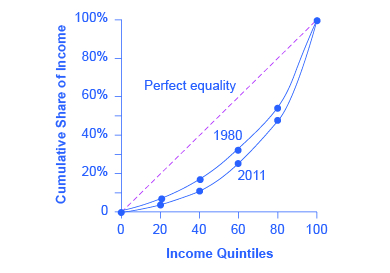
Every Lorenz curve diagram begins with a line sloping up at a 45-degree angle, shown as a dashed line in Figure ane. The points along this line show what perfect equality of the income distribution looks like. It would mean, for example, that the bottom 20% of the income distribution receives twenty% of the total income, the bottom xl% gets 40% of total income, so on. The other lines reflect bodily U.S. data on inequality for 1980 and 2011.
The trick in graphing a Lorenz curve is that you must change the shares of income for each specific quintile, which are shown in the first column of numbers in Tabular array eight, into cumulative income, shown in the second column of numbers. For example, the lesser 40% of the cumulative income distribution will be the sum of the start and second quintiles; the bottom 60% of the cumulative income distribution volition be the sum of the first, second, and third quintiles, so on. The concluding entry in the cumulative income column needs to be 100%, considering past definition, 100% of the population receives 100% of the income.
| Income Category | Share of Income in 1980 (%) | Cumulative Share of Income in 1980 (%) | Share of Income in 2013 (%) | Cumulative Share of Income in 2013 (%) |
|---|---|---|---|---|
| First quintile | iv.2 | iv.2 | three.2 | three.ii |
| Second quintile | 10.ii | 14.4 | 8.4 | 11.6 |
| Third quintile | 16.8 | 31.ii | 14.4 | 26.0 |
| Quaternary quintile | 24.7 | 55.9 | 23.0 | 49.0 |
| Fifth quintile | 44.1 | 100.0 | 51.0 | 100.0 |
| Table 8. Calculating the Lorenz Bend | ||||
In a Lorenz bend diagram, a more than unequal distribution of income will loop further down and abroad from the 45-caste line, while a more equal distribution of income volition move the line closer to the 45-degree line. The greater inequality of the U.S. income distribution between 1980 and 2013 is illustrated in Figure 1 because the Lorenz curve for 2013 is further from the 45-degree line than the Lorenz curve for 1980. The Lorenz curve is a useful fashion of presenting the quintile data that provides an image of all the quintile data at once. The next Clear Information technology Up characteristic shows how income inequality differs in various countries compared to the United States.
How does economic inequality vary around the world?
The U.Southward. economy has a relatively high degree of income inequality by global standards. Every bit Tabular array 9 shows, based on a variety of national surveys done for a selection of years in the last five years of the 2000s (with the exception of Germany, and adjusted to make the measures more comparable), the U.S. economy has greater inequality than Germany (forth with nearly Western European countries). The region of the world with the highest level of income inequality is Latin America, illustrated in the numbers for Brazil and United mexican states. The level of inequality in the United States is lower than in some of the depression-income countries of the world, like China and Nigeria, or some middle-income countries like the Russian Federation. However, not all poor countries have highly diff income distributions; India provides a counterexample.
| Country | Survey Year | Commencement Quintile | 2d Quintile | Third Quintile | Fourth Quintile | 5th Quintile |
|---|---|---|---|---|---|---|
| United States | 2013 | iii.2% | eight.iv% | 14.4% | 23.0% | 51.0% |
| Germany | 2000 | 8.v% | xiii.7% | 17.8% | 23.one% | 36.9% |
| Brazil | 2009 | 2.9% | 7.1% | 12.4% | 19.0% | 58.6% |
| Mexico | 2010 | 4.9% | viii.8% | thirteen.3% | xx.2% | 52.viii% |
| China | 2009 | iv.seven% | 9.vii% | xv.iii% | 23.2% | 47.1% |
| Bharat | 2010 | 8.5% | 12.1% | 15.vii% | xx.8% | 42.viii% |
| Russia | 2009 | 6.1% | ten.4% | 14.8% | 21.3% | 47.i% |
| Nigeria | 2010 | 4.4% | 8.3% | 13.0% | 20.3% | 54.0% |
| Table nine. Income Distribution in Select Countries. (Source: U.South. data from U.South. Census Bureau Table 2. Other data from The World Bank Poverty and Inequality Data Base, http://databank.worldbank.org/information/views/reports/tableview.aspx#) | ||||||
Visit this website to sentinel a video of wealth inequality across the world.

Causes of Growing Inequality: The Irresolute Limerick of American Households
In 1970, 41% of married women were in the labor strength, but by 2015, co-ordinate to the Bureau of Labor Statistics, 56.7% of married women were in the labor force. One issue of this trend is that more households have 2 earners. Moreover, it has get more than common for i high earner to ally another loftier earner. A few decades ago, the common design featured a man with relatively loftier earnings, such equally an executive or a doctor, marrying a woman who did non earn as much, like a secretary or a nurse. Ofttimes, the adult female would exit paid employment, at least for a few years, to heighten a family. Even so, now doctors are marrying doctors and executives are marrying executives, and mothers with high-powered careers are oft returning to work while their children are quite young. This blueprint of households with two high earners tends to increment the proportion of high-earning households.
Co-ordinate to data in the National Periodical, even equally 2-earner couples take increased, so have unmarried-parent households. Of all U.Due south. families, 13.1% were headed by single mothers; the poverty rate among single-parent households tends to exist relatively high.
These changes in family structure, including the growth of single-parent families who tend to be at the lower cease of the income distribution, and the growth of ii-career high-earner couples virtually the top end of the income distribution, account for roughly half of the rise in income inequality across households in recent decades.
Visit this website to sentry a video that illustrates the distribution of wealth in the United States.

Causes of Growing Inequality: A Shift in the Distribution of Wages
Some other factor behind the ascension in U.Due south. income inequality is that earnings accept go less equal since the belatedly 1970s. In detail, the earnings of loftier-skilled labor relative to low-skilled labor take increased. Winner-take-all labor markets result from changes in technology, which have increased global demand for "stars,"—whether the best CEO, md, basketball game actor, or actor. This global demand pushes salaries far in a higher place productivity differences versus educational differences. 1 style to measure this change is to take the earnings of workers with at least a four-year college available's degree (including those who went on and completed an avant-garde degree) and split them by the earnings of workers with only a high schoolhouse degree. The consequence is that those in the 25–34 age subclass with college degrees earned about i.67 times every bit much as high school graduates in 2010, up from i.59 times in 1995, co-ordinate to U.S. Census data. Winner-take-all labor market theory argues that the salary gap between the median and the acme 1 percent is not due to educational differences.
Economists use the demand and supply model to reason through the nearly likely causes of this shift. According to the National Center for Education Statistics, in recent decades, the supply of U.S. workers with higher degrees has increased essentially; for example, 840,000 four-year bachelor's degrees were conferred on Americans in 1970; in 2009–2010, 1,602,480 such degrees were conferred—an increase of about 90%. In Figure 2, this shift in supply to the right, from S0 to Southward1, should event in a lower equilibrium wage for high-skilled labor. Thus, the increase in the price of high-skilled labor must be explained by a greater need, like the movement from D0 to D1. Evidently, combining both the increment in supply and in demand has resulted in a shift from E0 to E1, and a resulting higher wage.
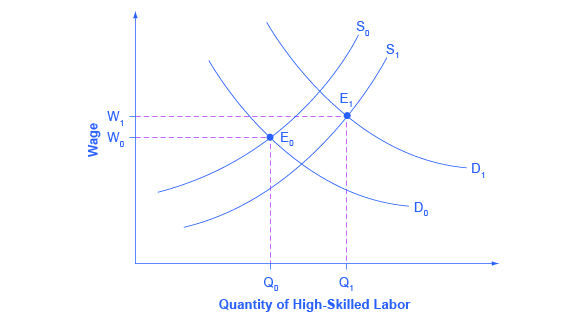
What factors would cause the demand for high-skilled labor to rise? The most plausible caption is that while the explosion in new information and communications technologies over the last several decades has helped many workers to go more productive, the benefits have been specially dandy for high-skilled workers like meridian business managers, consultants, and design professionals. The new technologies have also helped to encourage globalization, the remarkable increment in international trade over the last few decades, by making it more possible to learn about and coordinate economic interactions all around the world. In plough, the ascension impact of foreign trade in the U.S. economy has opened up greater opportunities for high-skilled workers to sell their services around the world. And lower-skilled workers have to compete with a larger supply of similarly skilled workers around the globe.
The market for high-skilled labor can be viewed every bit a race between forces of supply and demand. Additional education and on-the-task grooming volition tend to increment the supply of high-skilled labor and to hold down its relative wage. Conversely, new technology and other economic trends like globalization tend to increase the demand for loftier-skilled labor and button upwardly its relative wage. The greater inequality of wages tin can be viewed every bit a sign that demand for skilled labor is increasing faster than supply. On the other mitt, if the supply of lower skilled workers exceeds the demand, then average wages in the lower quintiles of the income distribution volition decrease. The combination of forces in the high-skilled and low-skilled labor markets leads to increased income disparity.
Key Concepts and Summary
Measuring inequality involves making comparisons across the entire distribution of income, non just the poor. 1 way of doing this is to dissever the population into groups, similar quintiles, and then calculate what share of income is received by each group. An alternative approach is to depict Lorenz curves, which compare the cumulative income actually received to a perfectly equal distribution of income. Income inequality in the Us increased substantially from the late 1970s and early 1980s into the 2000s. The two most common explanations cited by economists are changes in the construction of households that take led to more than two-earner couples and unmarried-parent families, and the effect of new data and communications engineering on wages.
Cocky-Check Questions
- A grouping of 10 people have the following annual incomes: $24,000, $18,000, $fifty,000, $100,000, $12,000, $36,000, $80,000, $x,000, $24,000, $xvi,000. Calculate the share of total income received by each quintile of this income distribution. Do the top and lesser quintiles in this distribution have a greater or larger share of total income than the pinnacle and bottom quintiles of the U.Due south. income distribution?
- Table 10 shows the share of income going to each quintile of the income distribution for the United Kingdom in 1979 and 1991. Use this data to summate what the points on a Lorenz curve would be, and sketch the Lorenz bend. How did inequality in the Uk shift over this time menstruation? How tin you run into the patterns in the quintiles in the Lorenz curves?
Share of Income 1979 1991 Top quintile 39.7% 42.ix% Fourth quintile 24.8% 22.7% Middle quintile 17.0% sixteen.3% 2d quintile 11.five% 11.5% Bottom quintile 7.0% 6.6% Table ten. Income Distribution in the Great britain, 1979 and 1991 - Using two demand and supply diagrams, one for the low-wage labor marketplace and one for the high-wage labor market, explain how information technology can increase income inequality if it is a complement to high-income workers like salespeople and managers, only a substitute for depression-income workers like file clerks and phone receptionists.
- Using two demand and supply diagrams, one for the low-wage labor market place and 1 for the high-wage labor market place, explain how a program that increased educational levels for a substantial number of low-skill workers could reduce income inequality.
Review Questions
- Who is included in the pinnacle income quintile?
- What is measured on the 2 axes of a Lorenz curve?
- If a country had perfect income equality what would the Lorenz curve await like?
- How has the inequality of income changed in the U.S. economy since the late 1970s?
- What are some reasons why a certain degree of inequality of income would be expected in a market place economy?
- What are the main reasons economists give for the increase in inequality of incomes?
Disquisitional Thinking Questions
- Explain how a land may experience greater equality in the distribution of income, yet even so experience high rates of poverty Hint: Look at the Articulate It Up "How is poverty measured in low-income countries?" and compare to Table 7.
- The need for skilled workers in the United states of america has been increasing. To increase the supply of skilled workers, many contend that immigration reform to allow more than skilled labor into the United States is needed. Explicate whether you lot agree or disagree.
- Explain a situation using the supply and demand for skilled labor in which the increased number of college graduates leads to depressed wages. Given the rising cost of going to college, explain why a college education will or will not increment income inequality.
Problems
A group of 10 people have the following annual incomes: $55,000, $30,000, $xv,000, $twenty,000, $35,000, $80,000, $40,000, $45,000, $thirty,000, $50,000. Calculate the share of total income received past each quintile of this income distribution. Do the tiptop and bottom quintiles in this distribution have a greater or larger share of total income than the top and bottom quintiles of the U.South. income distribution for 2005?
References
Frank, Robert H., and Philip J. Cook. The Winner-Accept-All Gild. New York: Martin Kessler Books at The Free Press, 1995.
Institute of Pedagogy Sciences: National Heart for Educational activity Statistics. "Fast Facts: Degrees Conferred by Sex and Race." http://nces.ed.gov/fastfacts/display.asp?id=72.
Nhan, Doris. "Census: More in U.Due south. Report Nontraditional Households." National Journal. Last modified May ane, 2012. http://www.nationaljournal.com/thenextamerica/demographics/census-more-in-u-due south-report-nontraditional-households-20120430.
U.Southward. Bureau of Labor Statistics: BLS Reports. "Report 1040: Women in the Labor Force: A Databook." Final modified March 26, 2013. http://world wide web.bls.gov/cps/wlf-databook-2012.pdf.
U.S. Department of Commerce: United states Demography Agency. "Income: Table H-2. Share of Aggregate Income Received by Each Fifth and Acme 5 Percentage of Households." http://www.demography.gov/hhes/www/income/data/historical/household/.
U.s.a. Demography Bureau. 2014. "2013 Highlights." Accessed April 13, 2015. http://www.census.gov/hhes/www/poverty/about/overview/.
Us Census Agency. 2014. "Historical Income Tables: Households: Table H-ii Share of Aggregate Income Received past Each Fifth and Peak 5% of Income. All Races." Accessed April 13, 2015. http://www.census.gov/hhes/www/income/information/historical/household/.
Glossary
- Lorenz curve
- a graph that compares the cumulative income really received to a perfectly equal distribution of income; it shows the share of population on the horizontal axis and the cumulative percentage of total income received on the vertical centrality
- quintile
- dividing a grouping into fifths, a method often used to wait at distribution of income
Solutions
Answers to Self-Bank check Questions
- A useful first step is to rank the households by income, from lowest to highest. And then, since there are x households full, the bottom quintile will be the bottom two households, the 2nd quintile will be the third and fourth households, then on up to the top quintile. The quintiles and percentage of total income for the data provided are shown in the following table. Comparison this distribution to the U.S. income distribution for 2005, the tiptop quintile in the example has a smaller share of total income than in the U.S. distribution and the lesser quintile has a larger share. This pattern usually means that the income distribution in the example is more equal than the U.S. distribution.
Income Quintile % of Total Income $10,000 Total first quintile income: $22,000 half-dozen.0% $12,000 $xvi,000 Total 2nd quintile income: $34,000 nine.ii% $18,000 $24,000 Total third quintile income: $48,000 13.0% $24,000 $36,000 Full fourth quintile income: $86,000 23.two% $l,000 $80,000 Total acme quintile income: $180,000 48.6% $100,000 $370,000 Full Income Table 11. - Just from glancing at the quintile data, it is adequately obvious that income inequality increased in the United Kingdom over this time: The peak quintile is getting a lot more, and the lowest quintile is getting a bit less. Converting this information into a Lorenz bend, yet, is a little trickier, considering the Lorenz bend graphs the cumulative distribution, non the amount received by individual quintiles. Thus, as explained in the text, you have to add up the individual quintile information to convert the data to this form. The post-obit table shows the actual calculations for the share of income in 1979 versus 1991. The figure following the table shows the perfect equality line and the Lorenz curves for 1979 and 1991. As shown, the income distribution in 1979 was closer to the perfect equality line than the income distribution in 1991—that is, the United Kingdom income distribution became more unequal over time.
Share of income received 1979 1991 Lesser 20% 7.0% 6.6% Bottom 40% 18.5% eighteen.one% Bottom 60% 35.five% 34.4% Bottom 80% 60.iii% 57.1% All 100% 100.0% 100.0% Table 12. 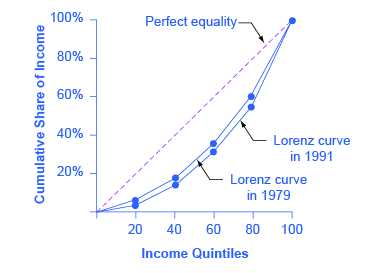
Figure 3. - In the market for low-wage labor, it shifts the need for depression-wage labor to the left. 1 reason is that technology can often substitute for depression-wage labor in sure kinds of telephone or accounting jobs. In addition, information engineering science makes information technology easier for companies to manage connections with low-wage workers in other countries, thus reducing the demand for depression-wage workers in the U.s.. In the market for high-wage labor, information engineering science shifts the demand for high-wage labor to the right. By using the new information and communications technologies, high-wage labor tin can get more productive and can oversee more tasks than before. The following figure illustrates these two labor markets. The combination of lower wages for low-wage labor and higher wages for high-wage labor ways greater inequality.
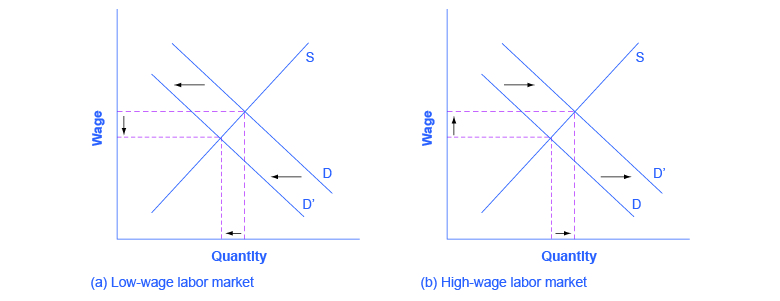
Figure 4. - In the market for low-wage labor, a skills program volition shift supply to the left, which will tend to drive upwardly wages for the remaining low-skill workers. In the market for high-wage labor, a skills programme will shift supply to the correct (considering after the training program there are now more high-skilled workers at every wage), which will tend to bulldoze downward wages for high-skill workers. The combination of these two programs volition result in a bottom caste of inequality. The post-obit figure illustrates these two labor markets. In the market for loftier-wage labor, a skills program will shift supply to the right, which will tend to drive downwards wages for loftier-skill workers.
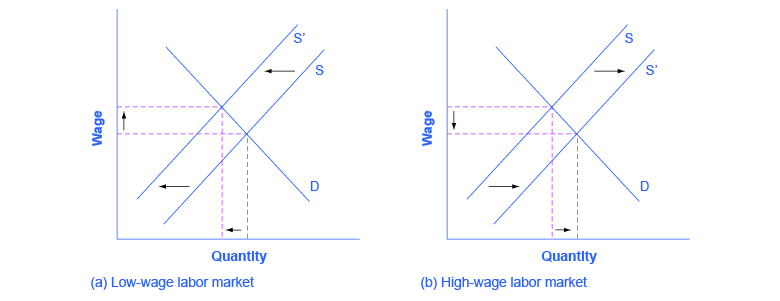
Figure 5.
Source: https://opentextbc.ca/principlesofeconomics/chapter/14-4-income-inequality-measurement-and-causes/
0 Response to "What Does the Lorenz Curve Measure in the Economy? << Read Less"
Post a Comment